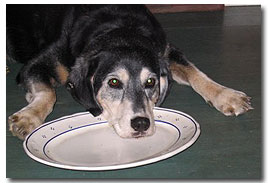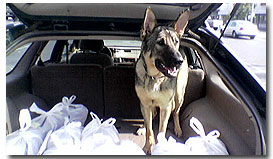Raw Feeding Basics
 The
basic premise behind this diet is that dogs are
descended from wolves, and have digestive systems
that were structured to eat raw foods. Raw foods
contain enzymes required for proper digestion. Many
dry or canned foods contain grains, which create
difficulties for a dog’s digestive system. In
addition, these foods are processed at high
temperatures, thereby killing many nutrients and
enzymes. This can lead to voluminous and/or loose
stools, coprophagia (since these stools contain
undigested food), food allergies, tartar build-up on
teeth, and obesity. There are even studies showing a
decrease in epileptic seizures when grains are
removed from a dog’s diet. Compare this to a human
being eating nothing but junk food. Junk food in
itself will not cause death, but a steady diet will
drastically affect a person’s health and longevity.
The same is true for our dogs. A diet change is not
a quick fix, but it can provide the building blocks
for good health over time. The
basic premise behind this diet is that dogs are
descended from wolves, and have digestive systems
that were structured to eat raw foods. Raw foods
contain enzymes required for proper digestion. Many
dry or canned foods contain grains, which create
difficulties for a dog’s digestive system. In
addition, these foods are processed at high
temperatures, thereby killing many nutrients and
enzymes. This can lead to voluminous and/or loose
stools, coprophagia (since these stools contain
undigested food), food allergies, tartar build-up on
teeth, and obesity. There are even studies showing a
decrease in epileptic seizures when grains are
removed from a dog’s diet. Compare this to a human
being eating nothing but junk food. Junk food in
itself will not cause death, but a steady diet will
drastically affect a person’s health and longevity.
The same is true for our dogs. A diet change is not
a quick fix, but it can provide the building blocks
for good health over time.
Upon beginning a raw diet, immediately you should
see decreased stool volume and firmer consistency.
There should be little odor and decreased flies. In
addition, your dog should drink less water, since
raw food contains high water content. (Although,
always keep plenty of clean drinking water available
at all times.) Do not expect to see drastic changes
in coat or muscle tone immediately. Most people
report seeing changes gradually over time, similar
to making diet changes in your own life.
We recommend feeding 2%-3% of your dog’s desired
weight per day. For example, a 20 lb. dog of average
weight should be fed 2.5% of their desired weight
per day (0.5 lb. per day or 8 oz.) Overweight dogs
should eat slightly less. Underweight or extremely
active dogs should eat slightly more. Puppies and
pregnant females should be fed more food, more
frequently. These are just general guidelines, and
you know your dog better than anyone. The best rule
of thumb is to feel your dog’s sides. His ribs
should feel similar to how the top of your hand
feels.

Safe Handling Guidelines:
- Keep food frozen until use
- Thaw as needed
- Do not cook
- Pick up and refrigerate any food not eaten
within 15 minutes
- We recommend feeding/water bowls be made of
stainless steel or glass.
- Clean dishes in hot soapy water after each
meal
 |
|
It's lucky this order made
it home! |
|